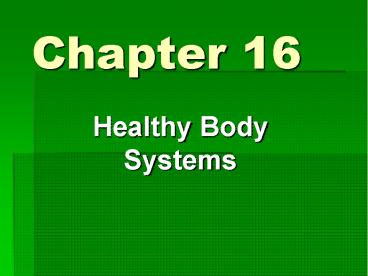Healthy Body Systems PowerPoint PPT Presentation
Title: Healthy Body Systems
1
Chapter 16
- Healthy Body Systems
2
The Cell
- The smallest unit of structure in a living
organism - Robert Hooke Identified coined the term
Cell when he saw cork under the microscope - He used a compound microscope
3
Cells
- Leeuwenhoek used a simple microscope and looked
at pond water - He saw living creatures that swam and moved
around calling them animicules
4
The Cell Theory
- The relationship between cells and living things
- All living things are composed of cells
- Cells are the basic unit of structure
- All cells are produced from other cells
5
Cellular Organization
- Cells ? Tissue ? Organs ? Organ System ? Organism
- Cells The basic unit of structure of all living
things - Most cells contain cell membrane, cytoplasm,
organelles a nucleus. - Tissue a group of similar cells that perform a
similar function - Organ Different tissues that all work together
performing a specific job - Examples Heart, liver, brain, lungs, femur,
spleen, stomach, kidneys - Organ System a group of related organs working
together to perform a major function - 11 human systems recognized include the digestive
and respiratory
6
An Organ a collection of tissues
7
4 Main Types of Tissue
- Muscle Tissue tissues w/ the ability to
contract - Striated, Smooth Cardiac
- Nerve Tissue tissues w/ the ability to send
receive electrical impulses - Brain, spinal cord nerve cells
- Epithelial Tissue tissues that cover the
surfaces of the body (inside out) - Skin, linings of the mouth, stomach intestinal
linings - Connective Tissue tissues that provide support
structure to the body - Bones, ligaments, tendons, cartilage, fat,
blood
8
Keeping the Body in Balance
- Homeostasis the process that keeps the bodys
internal environment stable in spite of ever
changing external environmental conditions - Maintaining body temperature via sweating, hard
breathing etc. - Stress disturbs homeostasis and the body reacts
to return to normal - Fight or Flight Syndrome - Adrenaline
9
11 Human Organ Systems
Endocrine
Circulatory
Digestive
Excretory
Musculature
Immune
Integumentary
Respiratory
Nervous
Reproductive
Skeletal
Skeletal
Skeletal
Skeletal
Skeletal
Skeletal
Skeletal
Skeletal
Skeletal
Skeletal
Skeletal
10
The Circulatory System
- carries materials to and away from all body cells
- includes the heart (duel pump), arteries, veins,
capillaries and blood
11
The Digestive System
- takes food and converts it into materials that
can be used at the cellular level - includes the esophagus, stomach, small
intestines, large intestines, etc.
12
The Endocrine System
- controls many of the body functions by the
release of hormones that affect the other body
systems - include the adrenal glands, the thalamus,
hypothalamus and thyroid glands
13
The Excretory System
- takes waste products made at the cellular level
and removes them from the blood. - Examples include kidneys, ureter, urethra and the
bladder.
14
The Immune System
- Used to fight of infections from bacteria
viruses (some include as part of circulatory
system) - includes the lymph vessels, nodes, T cells, B
cells, lymphocytes other antibodies
15
The Musculature System
- enables the body to move, moves food thru the
digestive system, keeps the heart beating - include biceps, heart, smooth muscle, triceps and
the Gluteus maximus.
16
The Nervous System
- detects and interprets information the body
receives from the outside environment and allows
the body to react accordingly - Examples include the brain, spinal cord, and
sensory organs
17
The Reproductive System
- allows for the continuation of life, produces sex
cells that allow for creation of offspring.
Controls male and female characteristics. - Include testes, uterus, ovaries, sperm, egg, etc.
18
The Respiratory System
- supplies oxygen to the body while removing carbon
dioxide - include the lungs, trachea and bronchi,
bronchioli, alveoli diaphragm.
19
The Skeletal System
- supports, gives shape and protects the body.
Serves as attachment for the muscles and produces
new blood cells in its marrow. - Examples include the ribs, femur, humerous and
phalanges
20
The Integumentary System
- the skin and its underlying materials protects
the body, water regulation and maintains body
temperature. - includes the skin, oil glands, hair
suncutaneous fat
21
Chapter 16
- Thats All Folks!!

